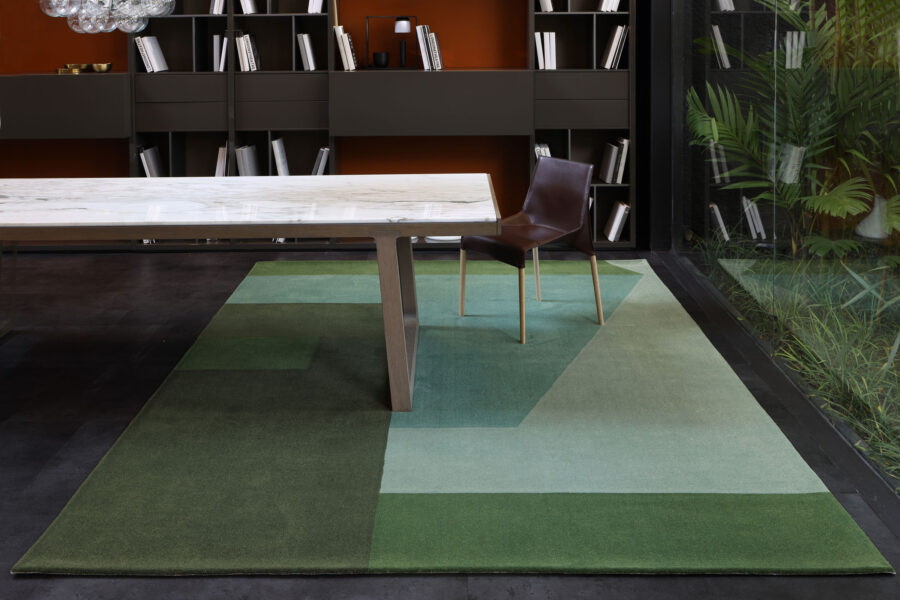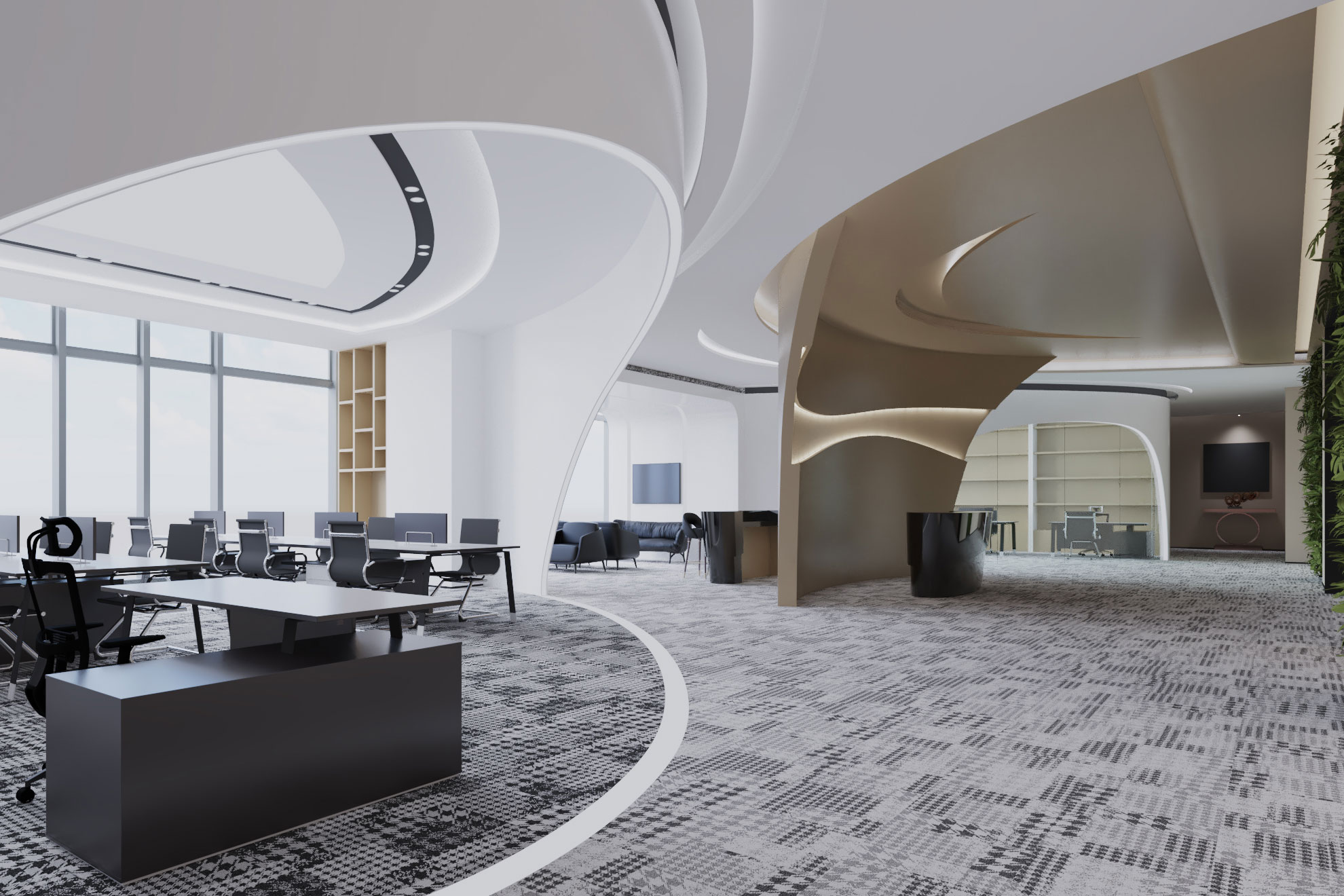Story at a glance:
- Interiors are often overlooked when it comes to how teams can lower the embodied carbon of a building.
- Many offices, hotels, and other spaces experience cyclical renovations that emit a lot of carbon.
- Manufacturers like Aquafil are working to help design teams create interior spaces that are less harmful.
Interiors are ever-changing. Buildings are responsible for 40% of global energy consumption through their lifetimes—and much of that is coming from inside. Many interiors have a relatively short life—especially in areas like the hospitality industry, where an interior might be replaced every seven or 10 years, according to the New York School of Interior Design. That’s a lot of potential waste.
Too often the interiors are overlooked when it comes to lowering the embodied carbon of a building. Many office spaces, hotels, convention spaces, and other commercial buildings go through cyclical renovations that emit a lot of carbon. That can be prevented and reduced when design teams create interior spaces that are multi-faceted—designing spaces with solutions that can be deconstructed, and designing places that can evolve.
Examples of Design for Deconstruction
Aquafil is one company that’s spent many years coming up with solutions to improve interior design. Their signature product ECONYLⓇ nylon is made entirely from waste, is 100% regenerable, and offers up to a 90% reduction in global warming potential compared to standard nylon made from petroleum. Designers are increasingly turning to solutions like these to create incredible new designs—from carpet to chairs to even handbags.
“Our philosophy is to design with the end in mind. It’s a mindset shift that many manufacturers have not considered yet,” says Eric Nelson, executive vice president of the Aquafil Carpet Recycling program. “And by trying to do business with like-minded companies, we hope to expand that thinking into a broader circular economy.”
ECONYL nylon performs the exact same as standard nylon; the only difference is its raw material is made from fishing nets, fabric and carpet scraps, and other nylon waste, while standard nylon is made from oil. Aquafil has been in the nylon business for decades, and the shift to 100% regenerable and made from waste was a massive undertaking. They started to develop ECONYL nylon in 2006. “This was really a big step. It’s the focus of our business and what we intend to do in the future almost exclusively,” Nelson says.
For every 10,000 tons of ECONYL raw material 70,000 barrels of crude oil and 65,000 tons of carbon dioxide emissions are avoided. Today more than 2,500 brands around the world are designing new products made with ECONYL nylon. “It’s not just carpet. It goes into so many different things.” Aquafil works closely with those who buy their nylon fiber to help them create products that can be reused and recycled at end of life.
Emphasis on Recycling

Nylon 6 waste for regeneration into ECONYL nylon. Photo courtesy of Aquafil
“Carpet is a lot thicker in the US than in different parts of the world, so it made sense to invest in nylon recycling here because the amount of material we could get for every square foot of carpet was a lot higher.”
Aquafil built its US carpet recycling plant in Arizona in 2017 to keep up with the demand. Today they have four collection facilities throughout Southern California and Arizona, and they can collect old carpet from just about anywhere. Nelson says they collect roughly 35 million pounds at their deconstruction plant each year from both residential and commercial sectors. “It makes a massive impact on the embodied carbon of each pound of nylon, doing it this way, as opposed to making it from petroleum.”
Aquafil wants to educate carpet installers everywhere—don’t just throw old carpet out. “How do we make sure that old stuff they put in their truck at the end of the day comes to us and not the landfill?” he asks.
One way they do that is by incentivizing them to bring it to the Aquafil facility. Alternatively, they can take the old carpet back to their retail locations and Aquafil will have one of their trailers or rollout bins there waiting. “There are a lot of different ways we try to collect, and it’s worked out pretty well for us. Our business has increased over the last several years,” Nelson says.
Aquafil is fortunate in part that California has what’s called Extended Producer Responsibility, or EPR legislation, specifically for carpet. The EPR program includes the Carpet Stewardship Program, which ensures post-consumer carpet is reused, recycled, or properly disposed of.
“That’s one of the reasons we chose the West Coast for this business,” Nelson says. “If you look at the recycling rate of old carpet, California is at about 34%. The rest of the country sees less than 5% of carpets recycled. Those incentives and subsidies make a huge difference when it comes to recycling old carpeting, but carpet is not the only thing. There are California laws now for lots of different materials—mattresses, paint, electronics, and so on.”
Future Design Possibilities

Punto e Filo Rug Made with ECONYL nylon. Photo courtesy of Aquafil
Demand for more sustainable interiors is growing. While Nelson says Europe appears to be slightly ahead in this regard, the desire to source products made with a very high percentage of recycled content is catching on everywhere.
The future is bright, and Aquafil continues to work with interior designers and architects to dream and create the impossible. They recently launched a program they call Born Regenerated to be Regenerable—or Born R2R. The project is a new way of eco-designing carpets and considering their end of life.
Born R2R aims to engage manufacturers in the carpet industry to co-design carpets with Aquafil made with ECONYL regenerated yarn, so instead of being disposed of in a landfill at the end of their useful life, they can be fully regenerated and repurposed into something new—closing the loop.
“We really intend to be deliberate in engaging not only the manufacturers of carpet, but also the designers and architects who specify these internal materials for commercial buildings,” Nelson says. “We want to be sure they understand all the benefits when it comes to embodied carbon impacts with the materials they choose.” In addition to reduced GWP, products made with ECONYL nylon can contribute to LEED V4 credits, for instance.
Much of the carpet that comes out of commercial buildings when they are renovated, for example, isn’t removed because it’s no good; it’s removed because a new tenant wants to redesign the space. When it comes time to renovate, the pros at Aquafil suggest teams reuse as many materials and products as possible, resell or donate the products they don’t need, use carpets that can be recycled and, of course, specify products made with sustainable materials that can be responsibly deconstructed.
Tips for Renovation
When it comes time to renovate, Aquafil encourages designers to:
1. Assess and plan. Thoroughly assess the building to identify key areas that need to be renovated and materials that can be repurposed.
2. Reuse materials. Salvage and reuse as much material from the existing building as possible.
3. Repurpose. When designers have additional materials that cannot be reused, identify local vendors/partners that reclaim and repurpose building materials.
4. Recycle. For any materials that can’t be repurposed or donated, contact local recycling facilities to see what materials they will collect and recycle. Aquafil Carpet Collection facilities across the Southwest collect and recycle old carpets, for example.
5. Source recycled and regenerable materials. If a renovation requires sourcing materials outside of the existing building, specify products that are made with recycled materials and that can be regenerated at the end of their useful life.
“Sending these materials to the landfill is not the way to go,” Nelson says. “There are so many advantages to recycling flooring and specifying products made with recycled content.”


